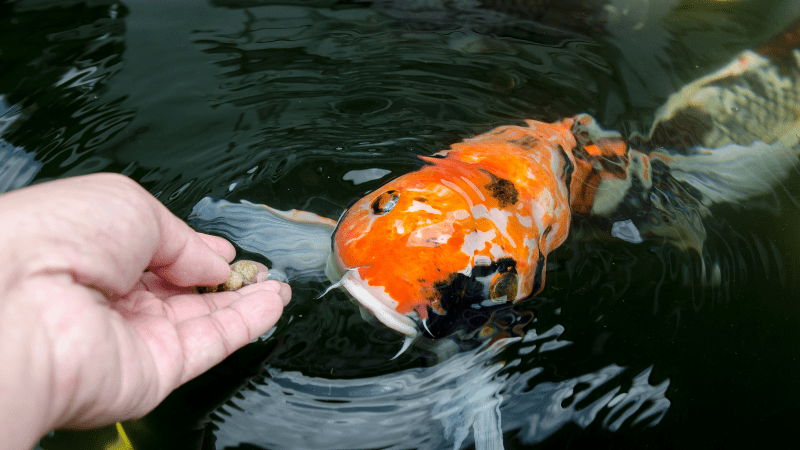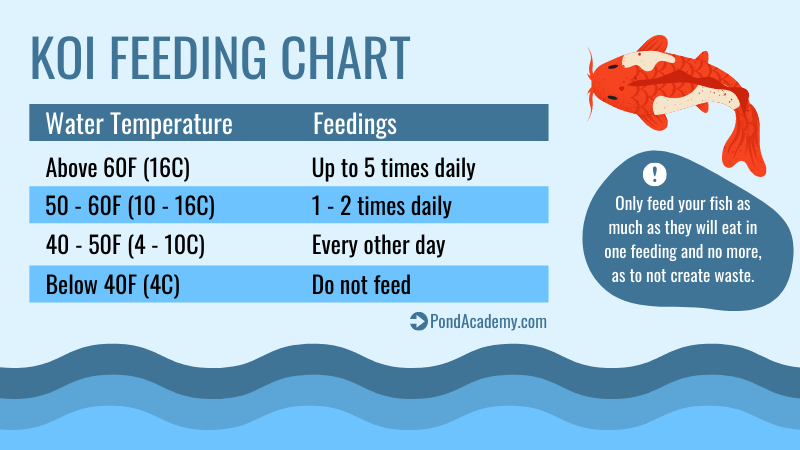Do You Have to Feed Koi Fish in a Pond? (Important Tips)
Pond Academy is reader-supported. Buying through links on our site may earn us an affiliate commission. As an Amazon Associate I earn from qualifying purchases.
One of the most common questions people ask about koi is whether or not you have to feed them.
The answer depends on several factors, including the size of your koi pond, the water temperature, the number of fish, and so on.
So, let's take a closer look at these factors to help you decide if you should feed the koi in your pond.
Do You Need to Feed Koi Fish in a Pond?

Technically speaking, you do not need to feed koi fish in a pond as long as it's not overstocked. Koi fish can naturally survive off a diet primarily made up of plant matter, algae, mosquito larvae, insects, and in some cases, koi will eat tadpoles if they are available.
Especially in the winter months, as koi enter a period of torpor. This is like hibernation because their body gets colder, and they have a slower heart rate and breathing rate (see Do Pond Fish Hibernate in Winter? for more information). During this time, your koi will not need to be fed, even if you regularly feed them in the summer months.
And as long as you follow the general rule of 1 female koi per 1,000 gallons of pond water or 1 male koi per 500 gallons (female koi are bigger), then the environment should provide enough natural food for your fish.
With that said, while it isn't necessary to feed koi fish in a pond (in many cases), supplying them with high-quality food can help improve koi lifespan, color, size, and health.
Plus, feeding fish like koi and goldfish is part of the joy of having them!
Get Our Best Pond Tips Sent to Your Inbox for Free!
Join thousands of others and learn from our decades of pond building and maintenance experience! Your pond will thank you!
By subscribing you agree to receive emails from PondAcademy.com. We will always respect your privacy and you can unsubscribe at any time.
How Often Should You Feed Koi Fish in a Pond?
If you've decided you want to feed your koi fish, one of the most important considerations is how often to feed them.
The temperature of the pond water will play a huge role in how often you feed your koi fish. Essentially, the colder the water is, the less koi fish eat.
For example, if the water temperature is above 60 degrees you can feed your koi up to 5 times per day, while water temps below 40 degrees you can stop feeding them altogether.
The best way to visualize this is with our koi feeding chart.
Koi Feeding Chart

![]() Important
Important
Be extra careful to not overfeed your koi. Give them only as much as they can eat in a few minutes. Slowly feed them and stop once you notice they are done eating. Overfeeding your fish will result in excess food sinking and decaying in the pond, contributing to the sludge on the pond floor, and causing water quality issues.
What to Feed Koi Fish
Equally as important as how often you feed your fish, is what you feed your fish!
There are many different types of koi food available. Ask your local pet store or fish supplier what they recommend.
Just be sure it's a high-quality koi food that:
- Is easily digestible.
- Floats on the surface of the pond.
- Contains all the necessary animal and vegetable proteins.
I highly recommend Kaytee Koi's Choice Premium Fish Food, as it meets all the above criteria and contains the essential nutrients needed for vibrant color, growth, health, and longevity.
Koi Feeding Tips
We now have a good idea if you need to feed the koi in your pond, how often, and what you should feed them.
So, let's ensure you're doing absolutely everything possible for the health and longevity of your little pets by outlining a few koi feeding tips.
- New fish sometimes take a few weeks to begin eating, so don't be surprised if they turn down your food right after introducing them to your pond.
- Besides fish food, koi enjoy eating foods that we humans consume, such as cereal, bread, various fruit and vegetables like lettuce and watermelon… pretty much anything that we enjoy eating. Just remember that these are treats and should not make up their entire diet.
- Don't forget to adjust their feedings in Spring and Fall as water temperatures change and stop feeding your fish altogether in winter.
- There isn't a certain month to stop feeding koi fish, instead, you'll want to stop feeding when the water temperature is below 40 degrees! Continuing to feed your fish during this time will cause more harm than good.
- Use a pond thermometer to monitor the water temperature so you know roughly how much to feed your koi.
- For healthy fish (and to help koi grow faster), feed them high-quality food like Kaytee Koi's Choice Premium Fish Food.
- If you're not around to feed them the recommended amounts each day, you can use an automatic pond fish feeder to dispense just the right amount of food at regular intervals throughout the day.
And remember, hand feeding your koi is fun, relieves stress, and is part of the joys of owning these beautiful creatures. Enjoy this time with your pond fish!





